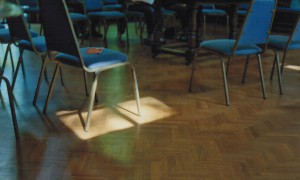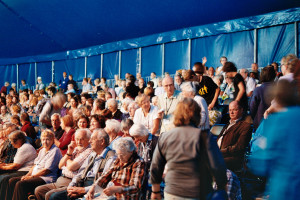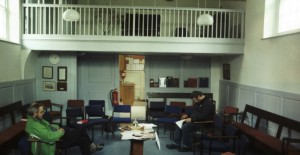Meeting for Worship. The heart of the Quaker way. I’d go every day if that were a practical possibility (which it is when I stay at Woodbrooke). I do usually go twice a week. Sometimes I look at myself on a Wednesday, re-arranging my work hours, walking for half an hour to the meeting house, to sit in silence, possibly alone, for half an hour and then spend at least that long getting home, and I wonder: why I am doing this? I have to conclude that ‘it matters’, because no-one is making me go to this trouble to be at meeting for worship, but it clearly matters a lot to me.
So what I am actually doing when I go to meeting for worship, what do we mean by ‘worship’ and why do I do it?
On one level the answer is that I’m setting aside time for God, time to align myself more closely with that loving creative force that I am aware of from time to time, but more strongly if I set aside time specifically to be aware. I’m also setting aside time for the community, even if I am the only person physically present. I am keeping the meeting. I sense a continuity with those who are prevented from being present at that time (by health, weather, other commitments) and with those who have been there before or are worshipping elsewhere. In our meeting house we have put up photographs of most of the people who regularly attend out meetings for worship. Sitting quietly in the room with the photographs it is easy to feel that they are, in a sense, present with me. It is important to me that worship is a communal activity. The actual numbers do not matter. Apparently alone; with 2 or 3 others; with 30 or 40 (as my meeting usually is on Sunday morning); with 90 others at a conference; with 1000+ in a big top at yearly Meeting Gathering, it is still essentially the same experience.
When I arrive at the appointed time and place, I’d like to be early, though I rarely am. I try to calm my busy brain and begin to settle into silence before I enter the room. That helps me to enter the worship and minimises disturbance to others who are already present. The contribution of those who arrive and settle into meeting before the appointed time is a very valuable ministry to the whole meeting. I like to sit somewhere that I can see others arriving, so that I can notice who is there, and offer a greeting smile if they look my way. I like to notice how many we are, who is absent, who may need some prayerful or practical support. Sometimes I will quietly step into the role of an absentee and act, perhaps, as doorkeeper, or fetch the collection bowl in the treasurer’s absence. Settling into meeting I adjust my posture so that my body is not bothering me. Like many others I find straight back, hands loosely in the lap, or open and receptive, feet both in contact with the floor, helpful – but worship is perfectly possible in other postures.
Then I need to quiet my busy mind, so I may concentrate on my breath, or silently recite a mantra (‘be still and know that I am God’ Psalm 46:10 is a personal favourite). My aim is to be inwardly silent and open, to be ready for whatever I may hear or be called to do.
Another phrase I now, somewhat to my surprise, find I use frequently as I settle deeper into worship is ‘here I am Lord’ Isaiah . I am waiting and ready for the unexpected, possibly the transformational. Often I will gain some small insight, very rarely is anything dramatically transformational – but other the years the small insights have added up and I have been changed a lot. That possibility of change, of transformation, of the unexpected, even, though it seems strange to say it about sitting in silence together, the exciting, is why I keep going to meeting.






Thank you, Stephanie. have copied this for the group I am running, “Curious about Quakers”. Tomorrow we look at worship, and it’s helpful to have a wide experience to share.
Meg, I’m glad that it’s helpful. I’ve found other short pieces about people’s personal experiences of worship helpful in similar circumstances.
Thank you for sharing this Stephanie. I too have found over the years a returning to the standpoint of addressing ‘God’ in the second person. Then I read Paul Smith’s book, Integral Christianity. He speaks of using three standpoints: first, second and third person. These enable me to talk ABOUT ‘God’ (3rd person), TO ‘God’ (2nd person) and AS ‘God’ (1st person). I found this liberating and helpful. Namaste.
Wondering whether you’d be OK with me using your picture of meeting for worship in the Big Top (above) in a presentation I and a Ffriend are giving about Quakerism to our local U3A. We’re both members of Hardshaw and Mann AM.
In Friendship
Jennie
That would be fine Jennie